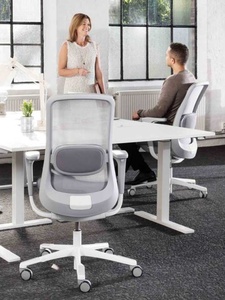Back pain is a common condition that affects over 80 percent of the population at some point in their lives. It's the most common reason people visit an orthopedic consultant. Back pain can occur in anyone, regardless of their age, ethnicity, or geographic location.
Causes of Upper Back Pain
While back pain can originate from different parts of the spine, the medical community agrees that it can begin in the neck, causing upper back pain or top of back pain. In contrast, mid back pain or thoracic spine pain can also be incapacitating but less common in older age groups.
Trauma or injury can cause upper back pain. Improper posture or prolonged muscular strain can also cause back pain variants like upper left back pain and upper back shoulder pain. For example, if you work on a computer for three or more hours a day, you may be at risk of developing top of the back pain or even upper left back pain due to improper posture or poor ergonomics.
Ergonomic Solutions for Upper Back Pain
Ergonomics is the process of fitting the job to the person to minimize the risk of muscular irritation and damage. Ergonomic solutions can help relieve back pain at the workplace, regardless of whether it's top of the back pain, mid back pain, or thoracic spine pain.
1. The Chair and Sitting Posture
The best upper back pain relief for an office worker is to look at your chair. Many people are sitting in the completely wrong chair for them. On the other side, some people are sitting in a chair that they purchased for a lot of money and it is deemed a top-end Ergonomic Chair, but it is set up incorrectly, thus proving useless.
To ensure optimal health and minimize the probability of contracting muscular irritation and damage, the chair should have adjustable armrests, seat height, seat depth, and back support. The chair should also have a lumbar support, and the edge of the seat should be soft and should not touch the back of the knee if thoracic spine pain and upper back pain relief are to be ensured.
The correct ergonomic sitting posture would include keeping the feet flat on the ground, the thighs parallel to the floor, knees at ninety degrees, and the back straight. The posture should be erect, comfortable, and relaxed, with no drooping or slouching of the shoulders at any point in time.
If you think you have the wrong chair for you, if it is set up incorrectly, or if you want advice, call 0504 60 202 or email enquiries@kos.ie for FREE advice.
2. The Workstation
Organizing the worktable can minimize the probability of upper left back pain, top of the shoulder pain, and mid back pain. You should arrange all the necessary items within easy reach to avoid twisting or stretching actions at any point in time.
3. Ergonomic Keyboard
Improper size or height of the keyboard tray can cause upper back and shoulder pain. Adjusting the seat height so that arms are level with the desk and ensuring the desk area is large enough to accommodate the keyboard and mouse is the best way to achieve this ergonomic workstation adjustment. It's known to provide instant upper back pain relief for most.
4. Adding a Monitor
Adjusting the height of the computer monitor so that the top of the screen is at the same level as the eyes can provide relief for upper back pain in computer users. We would always recommend adding a second monitor and never use just a laptop on it's own, unless absolutely necessary.
Using just the laptop screen can lead to hunching and can be a big cause of upper back pain, especially if used for prolonged periods. If you have to use just the laptop, you should add a laptop stand. The laptop stand should be able to allow you to lift the laptop screen to eye level.
For your second monitor, you should use a monitor arm that will allow you to easily move the monitor in a number of different positions to allow you to get as much pain relief for your upper back.
5. Take Breaks & Move Regularly
Here at KOS Ergonomics, we live by the motto, "Your Next Move Is Your Best Move"! This means that focusing on moving regularly can lead to a huge impact in relieving upper back pain.
A general rule of thumb should be to move at least every half an hour. This is where a Height-Adjustable Standing Desk comes in useful. By using a standing desk, you can sit for 20 mins and stand for 8 minutes, allowing you to improve circulation and reduce stiffness.
If you don't have a standing desk, you should still move every 30 minutes, even just to get a glass of water, a coffee, or to use the bathroom.
If you don't have room for a standing desk, you can convert your normal workstation into a standing workstation with a Sit-Stand Table Adaptor. This is a fantastic option for people will limited space or limited budget.
6. Stretching Regularly
By nature, humans don't stretch enough. If you have a pet dog or cat, you will notice that the first thing they do when they get up after lying down is to have a big stretch.
By incorporating a 5 minute stretch into your morning routine, you will see a huge relief from upper back pain in the long-run. You should also stretch for 5 minutes every half an hour, even just basic stretches. Ideally, you want to stretch the whole body as much as you can, but it might be a bit strange to roll around on the office floor
Here are 5 Simple Upper Back Stretches You can do in the office in 5 minutes;
1. Upper Back Opener
- Start by standing up fully straight.
- Lock your fingers behind your head, just above your neck.
- Tense your core and push your head back into your hands.
- Push forward with your hands and straighten your elbows.
- While tensed, look left for ten seconds and then look right for ten seconds.
2. Seated Twist
- Sit up straight with your feet flat on the floor.
- Place your right hand on your left knee and slowly twist your torso to the left.
- Hold for 10-15 seconds.
- Repeat with your left hand on your right knee, twisting to the right.
3. Doorway Stretch
- Stand in a doorway with your arms by your side.
- Place both hands on the frame of the door.
- Keep your elbows at shoulder height.
- Lean forward slowly.
- Hold for 15-30 seconds.
- This stretches your chest and upper back.
4. Doorway Stretch 2
- Stand in front of the door frame.
- Place your right hand inside the frame of the door.
- Place your right foot on the opposite side of the door from where your hand is.
- Place your left foot one step in front of your right foot.
- Push against the frame with your right hand while leaning into your left foot.
- Hold for 10-15 seconds.
- Repeat for both hands.
5. Shoulder Blade Stretch
- Sit upright in your chair.
- Place your right palm flat in the middle of your shoulder blades (just below your neck).
- Your right elbow should be almost straight above the back of your head.
- Use your left hand to slowly push your right elbow downwards.
- You will feel your palm slowly moving down your neck and back.
- Hold when it is comfortable for 10-15 seconds.
- Repeat with your left side.
Conclusion
Back pain can be debilitating and reduce work productivity. Adopting strategic ergonomic measures and manoeuvres can provide relief for back pain, regardless of whether it's thoracic spine pain, top of the back pain, or even an upper left back pain.
By following ergonomic solutions like proper sitting posture, organizing your worktable, adjusting keyboard ergonomics, and monitor height, you can minimize the probability of muscular irritation and damage, and experience instant relief for most upper back pain cases.















